4.4 Solving equations
|
Previous
4.3 Double angle identities
|
Next
4.5 Applications of trigonometric functions
|
4.4 Solving equations (EMCGH)
The general solution (EMCGJ)
The periodicity of the trigonometric functions means that there are an infinite number of positive and negative angles that satisfy an equation. If we do not restrict the solution, then we need to determine the general solution to the equation. We know that the sine and cosine functions have a period of \(\text{360}\)° and the tangent function has a period of \(\text{180}\)°.
Method for finding the solution:
- Simplify the equation using algebraic methods and trigonometric identities.
- Determine the reference angle (use a positive value).
- Use the CAST diagram to determine where the function is positive or negative (depending on the given equation/information).
- Restricted values: find the angles that lie within a specified interval by adding/subtracting multiples of the appropriate period.
- General solution: find the angles in the interval \([\text{0}°; \text{360}°]\) that satisfy the equation and add multiples of the period to each answer.
- Check answers using a calculator.
General solutions:
- \begin{align*} \text{If } \sin \theta &= x \\ \theta &= \sin^{-1}x + k \cdot \text{360}° \\ \text{or } \theta &= \left( \text{180}° - \sin^{-1}x \right) + k \cdot \text{360}° \end{align*}
- \begin{align*} \text{If } \cos \theta &= x \\ \theta &= \cos^{-1}x + k \cdot \text{360}° \\ \text{or } \theta &= \left( \text{360}° - \cos^{-1}x \right) + k \cdot \text{360}° \end{align*}
- \begin{align*}
\text{If } \tan \theta &= x \\
\theta &= \tan^{-1}x + k \cdot \text{180}°
\end{align*}
for \(k \in \mathbb{Z}\).
Worked example 9: Finding the general solution
Determine the general solution for \(\sin \theta = \text{0,3}\) (correct to one decimal place).
Use a calculator to find the reference angle
\begin{align*} \sin \theta &= \text{0,3} \\ \therefore \text{ref } \angle &= \sin^{-1}\text{0,3} \\ &= \text{17,5}° \end{align*}Use CAST diagram to determine in which quadrants \(\sin \theta\) is positive
The CAST diagram indicates that \(\sin \theta\) is positive in the first and second quadrants.
Using reduction formulae, we know that \(\sin (\text{180}° - \theta) = \sin \theta\).
In the first quadrant:
\begin{align*} \theta &= \text{17,5}° \\ \therefore \theta &= \text{17,5}° + k \cdot \text{360}° \end{align*}In the second quadrant:
\begin{align*} \theta &= \text{180}° - \text{17,5}° \\ \therefore \theta &= \text{162,5}° + k \cdot \text{360}° \end{align*}where \(k \in \mathbb{Z}\).
Check that the solution satisfies the original equation
We can select random values of \(k\) to check that the answers satisfy the original equation.
Let \(k = 4\):
\begin{align*} \theta &= \text{17,5}° + 4(\text{360})° \\ \therefore \theta &= \text{1 457,5}° \\ \text{And } \sin \text{1 457,5}° &= \text{0,3007} \ldots \end{align*}This solution is correct.
Similarly, if we let \(k = -2\):
\begin{align*} \theta &= \text{162,5}° - 2(\text{360})° \\ \therefore \theta &= -\text{557,5}° \\ \text{And } \sin (-\text{557,5}°) &= \text{0,3007} \ldots \end{align*}This solution is also correct.
Write the final answer
\(\theta = \text{17,5}° + k \cdot \text{360}°\) or \(\theta = \text{162,5}° + k \cdot \text{360}°\) for \(k \in \mathbb{Z}\).
Worked example 10: Trigonometric equations
Solve the following equation for \(y\), without using a calculator:
\(\frac{1-\sin{y}-\cos{2y}}{\sin{2y}-\cos{y}}=-1\)Simplify the equation
We first simplify the left-hand side of the equation using the double angle formulae. To solve this equation, we need to manipulate the given equation to be of the form:
\begin{align*} \text{single trigonometric ratio} &= \text{constant} \\ & \\ \frac{1-\sin{y}-\left(1-2{\sin}^{2}y\right)}{2\sin{y}\cos{y}-\cos{y}}& = -1 \\ \frac{2{\sin}^{2}y-\sin{y}}{\cos{y}\left(2\sin y-1\right)}& = -1 \\ \frac{\sin{y}\left(2\sin{y}-1\right)}{\cos{y}\left(2\sin{y}-1\right)}& = -1 \\ \frac{\sin{y}}{\cos{y}}& = -1 \\ \therefore \tan{y}& = -1 \end{align*}Use a calculator to find the reference angle
\begin{align*} \tan{y}& = -1 \\ \therefore \text{ref } \angle &= \tan^{-1} (1) \\ &= \text{45}° \end{align*}Use CAST diagram to determine in which quadrants \(\tan{y}\) is negative
The CAST diagram indicates that \(\tan y\) is negative in the second and fourth quadrants.
\begin{align*} y &= \left( \text{180}° - \text{45}° \right) + k \cdot \text{180}° \\ \therefore y &= \text{135}° + k \cdot \text{180}°, \quad k \in \mathbb{Z} \end{align*}Notice that for \(k=1\), \(y = \text{135}° + \text{180}° = \text{315}°\), which is the angle in the fourth quadrant.
Check that the solution satisfies the original equation
Write the final answer
\(y = \text{135}° + k \cdot \text{180}°\) where \(k \in \mathbb{Z}\).
Worked example 11: Trigonometric equations
Prove \(8 \cos^{4}x - 8 \cos^{2}x + 1 = \cos 4x\) and hence solve \(8 \cos^{4}x - 8 \cos^{2}x + 1 = \text{0,8}\) (correct to one decimal place).
Prove the identity
Expand the right-hand side of the identity and show that it is equal to the left-hand side:
\begin{align*} \text{RHS} & = \cos 4x \\ & = 2 \cos^{2}2x - 1 \\ & = 2 \left( 2\cos^{2}x - 1 \right)^{2} - 1 \\ & = 2 \left( 4\cos^{4}x - 4\cos^{2}x + 1 \right) - 1 \\ & = 8\cos^{4}x - 8\cos^{2}x + 2 - 1 \\ & = 8\cos^{4}x - 8\cos^{2}x + 1 \\ & = \text{LHS} \end{align*}Solve the equation
\begin{align*} 8\cos^{4}x - 8\cos^{2}x + 1 & = \text{0,8} \\ \therefore \cos 4x & = \text{0,8} \end{align*}Use a calculator to find the reference angle
\begin{align*} \cos 4x & = \text{0,8} \\ \therefore \text{ref } \angle &= \cos^{-1} (\text{0,8}) \\ &= \text{36,9}° \end{align*}Use CAST diagram to determine in which quadrants \(\cos 4x\) is positive
The CAST diagram indicates that \(\cos 4x\) is positive in the first and fourth quadrants.
In the first quadrant:
\begin{align*} 4x &= \text{36,9}° + k \cdot \text{360}° \\ \therefore x &= \text{9,2}° + k \cdot \text{90}° \end{align*}Important: remember to also divide \(k \cdot \text{360}°\) by \(\text{4}\).
In the fourth quadrant:
\begin{align*} 4x &= \left( \text{360}° - \text{36,9}° \right) + k \cdot \text{360}° \\ &= \text{323,1}° + k \cdot \text{360}° \\ \therefore x &= \text{80,8}° + k \cdot \text{90}° \end{align*}where \(k \in \mathbb{Z}\).
Check that the solution satisfies the original equation
Write the final answer
\begin{align*} x &= \text{9,2}° + k \cdot \text{90}° \\ \text{ or } x &= \text{80,8}° + k \cdot \text{90}°, \quad k \in \mathbb{Z} \end{align*}Worked example 12: Trigonometric equations
Find the general solution for \(\sin \theta \cos^{2} \theta = \sin^{3} \theta\).
Simplify the given equation
Do not divide both sides of the equation by \(\sin \theta\):
- part of the solution would be lost;
- we would need to restrict the values of \(\theta\) to those where \(\sin \theta \ne 0\) (division by zero is not permitted).
Apply the zero product law and solve for \(\theta\)
\begin{align*} \sin \theta \left( \cos \theta - \sin \theta \right) \left( \cos \theta + \sin \theta \right) &= 0 \\ & \\ \sin \theta &= 0 \\ \therefore \theta &= \text{0}° + k \cdot \text{360}° \\ \text{ or } \theta &= \text{180}° + k \cdot \text{360}°, \quad k \in \mathbb{Z} \end{align*}\begin{align*} \cos \theta - \sin \theta &= 0 \\ \cos \theta &= \sin \theta \\ \cos \theta &= \cos \left( \text{90}° - \theta \right) \\ \therefore \theta &= \left( \text{90}° - \theta \right) + k \cdot \text{360}° \\ 2 \theta &= \text{90}° + k \cdot \text{360}° \\ \therefore \theta &= \text{45}° + k \cdot \text{180}°, \quad k \in \mathbb{Z} \end{align*}\begin{align*} \cos \theta + \sin \theta &= 0 \\ \cos \theta &= - \sin \theta \\ \sin \left( \text{90}° + \theta \right) &= \sin (- \theta ) \\ \therefore \text{90}° + \theta &= - \theta + k \cdot \text{360}° \\ 2 \theta &= - \text{90}° + k \cdot \text{360}° \\ \therefore \theta &= - \text{45}° + k \cdot \text{180}°, \quad k \in \mathbb{Z} \end{align*}Write the final answer
\begin{align*} \theta &= \text{0}° + k \cdot \text{360}° \\ \text{ or } \theta &= \text{180}° + k \cdot \text{360}° \\ \text{ or } \theta &= \pm \text{45}° + k \cdot \text{180}°, \quad k \in \mathbb{Z} \end{align*}Solving trigonometric equations
Find the general solution for each of the following equations (correct to two decimal places):
We work with the left-hand side of the equation since it contains \(y\), which is easier to simplify than the double angle on the right-hand side:
\begin{align*} \cos y &= \sin 2y \\ \sin \left( \text{90}° - y \right) &= \sin 2y \\ \text{First quadrant: } \enspace \left( \text{90}° - y \right) + k \cdot \text{360}° &= 2y \\ \text{90}° + k \cdot \text{360}° &= 3y \\ \text{30}° + k \cdot \text{120}° &= y \\ & \\ \text{Second quadrant: } \enspace \text{180}° - \left( \text{90}° - y \right) + k \cdot \text{360}° &= 2y \\ \text{90}° + y + k \cdot \text{360}° &= 2y \\ \text{90}° + k \cdot \text{360}° &= y \end{align*}for \(k \in \mathbb{Z}\).
Restrictions:
\begin{align*} \text{For } & \tan A: \\ A &\ne \text{90}° + k \cdot \text{180}°, k \in \mathbb{Z} \\ \text{And for} \enspace \frac{1}{\tan A} & \enspace \text{we can write} \enspace \frac{\cos A}{\sin A}: \\ \therefore \sin A &\ne 0 \\ A &\ne \text{0}° + k \cdot \text{180}°, k \in \mathbb{Z} \end{align*}Restrictions:
\begin{align*} \text{For } \tan x &: \\ x &\ne \text{90} ° + k \cdot \text{180} °, \quad k \in \mathbb{Z} \end{align*}Given: \(\sin x \cos x = \sqrt{3} \sin^{2} x\)
The diagram below shows the graph of \(y = \sin x\) (grey) and \(y = \tan x\) (black).
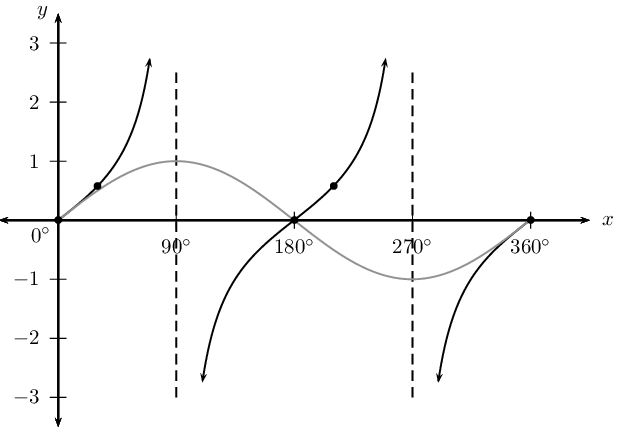
Given: \(1 + \tan^{2} 2A = 5 \tan 2A - 5\)
Therefore, there are ten solutions that lie within the interval \([- \text{90}°; \text{360}°]\).
First we simplify the left-hand side of the equation:
\begin{align*} \cos \left( A - \text{25}° \right)+ \cos \left( A + \text{25}° \right) &= \cos \text{25}° \\ \cos A \cos \text{25}° + \sin A \sin \text{25}° + \cos A \cos \text{25}° - \sin A \sin \text{25}° &= \cos \text{25}° \\ 2 \cos A \cos \text{25}° &= \cos \text{25}° \\ \therefore 2 \cos A &= 1 \quad (\cos \text{25}° \ne 0 ) \\ \cos A &= \frac{1}{2}\\ \therefore A &= \text{60}° + k \cdot \text{360}° \\ \text{ or } A = \text{300}° + k \cdot \text{360}°, & \quad k \in \mathbb{Z} \\ \therefore A = -\text{300}°, -\text{60}°, \text{60}° & \text{ or } \text{300}° \end{align*}The diagram below shows the graph of \(y = \sin 4 x\).
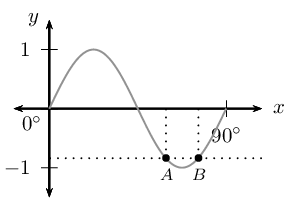
\(A( \text{59,26}°; -\text{0,84}),B( \text{75,74}°; -\text{0,84})\)
The period of the cosine function is \(\text{360}\)°. This means that the function values repeat after \(\text{360}\)°.
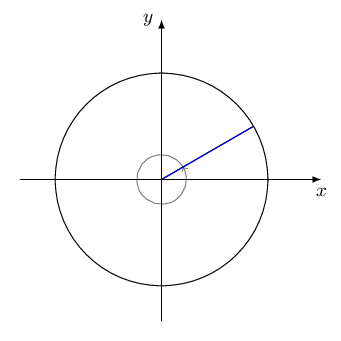

The period of the tangent function is \(\text{180}\)°. This means that the function values repeat after \(\text{180}\)°.
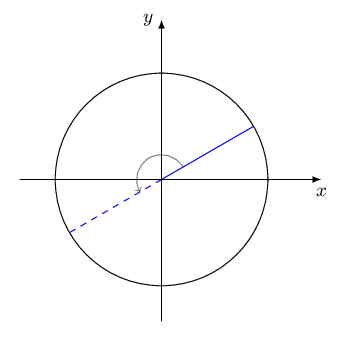
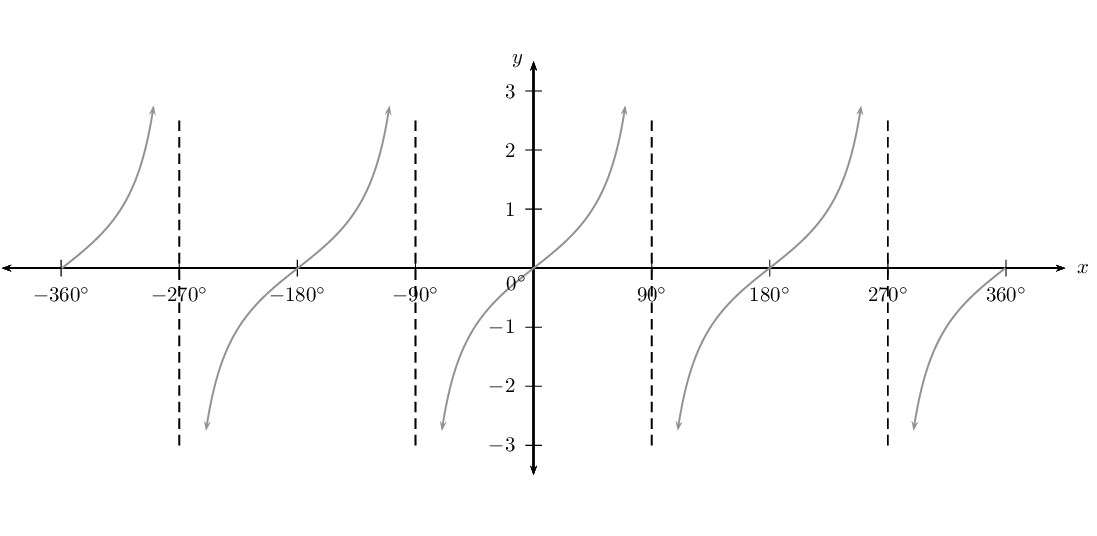
Check that both answers satisfy the original equation:
\begin{align*} \text{Substitute } x &= \text{60} ° \\ \therefore \text{LHS} &= \sqrt{3} \sin \text{60} ° + \cos \text{60} ° \\ &= \sqrt{3} \cdot \frac{\sqrt{3}}{2} + \frac{1}{2} \\ &= \frac{3}{2} + \frac{1}{2} \\ &= 2 \\ &= \text{RHS} \\ \text{Substitute } x &= \text{120} ° \\ \therefore \text{LHS} &= \sqrt{3} \sin \text{120} ° + \cos \text{120} ° \\ &= \sqrt{3} \cdot \frac{\sqrt{3}}{2} - \frac{1}{2} \\ &= \frac{3}{2} - \frac{1}{2} \\ &= 1 \\ &\ne \text{RHS} \end{align*}Therefore, \(x = \text{60} ° + k \cdot \text{360} °\).
|
Previous
4.3 Double angle identities
|
Table of Contents |
Next
4.5 Applications of trigonometric functions
|
